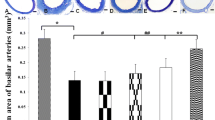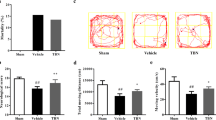Abstract
Objective
Adhesion molecules, including intercellular adhesion molecule-1 (ICAM-1), vascular cell adhesion molecule-1 (VCAM-1), and E-selectin, are important inflammatory mediators which are elevated in the serum of patients following aneurysmal subarachnoid hemorrhage (SAH). The authors previously found that 6-mercaptopurine (6-mp) was effective in preventing and reversing arterial narrowing in a rodent SAH model. The present study was to examine whether levels of adhesion molecules were altered after treatment with 6-mp in this animal model.
Materials and methods
Animals were each injected with autologous blood into the cisterna magna, and intraperitoneal treatment with 6-mp (2 mg/kg) was initiated 1 h before (prevention) or later (treatment). The compound was subsequently administered at 24 and 48 h post-SAH. Blood samples were collected at 72 h post-SAH to measure ICAM-1, VCAM-1, and E-selectin levels. The basilar arteries were harvested and sliced, and their cross-sectional areas were measured. Morphologically, convolution of the internal elastic lamina, distorted endothelial wall, and myonecrosis of the smooth muscle were prominently observed in the SAH only and vehicle-treated SAH groups, but not in the 6-mp-treated SAH group or in healthy controls. No significant differences were found in the levels of VCAM-1 among all groups. However, the levels of E-selectin were increased in all animals subjected to SAH (SAH only and SAH plus vehicle groups) compared with healthy controls (no SAH), but not in the 6-mp group (SAH plus 6-mp treatment and preventive treatment with 6-mp).Likewise, the levels of ICAM-1 in the SAH only and SAH plus vehicle groups were significantly elevated (p < 0.001), and pretreatment and treatment with 6-mp reduced ICAM-1 to control levels.
Conclusion
These results show that ICAM-1 and E-selectin may play a role in mediating SAH-induced vasospasm and that a reduction of both adhesive molecules after SAH may partly contribute to the antispastic effect of 6-mp.




Similar content being viewed by others
Abbreviations
- BA:
-
Basilar artery
- ICAM-1:
-
Intercellular adhesion molecule-1
- IEL:
-
Internal elastic lamina
- PBS:
-
Phosphate-buffered saline
- PECAM:
-
Platelet-endothelial adhesion molecule
- SAH:
-
Subarachnoid hemorrhage
References
Aihara Y, Kasuya H, Onda H, Hori T, Takeda J (2001) Quantitative analysis of gene expressions related to inflammation in canine spastic artery after subarachnoid hemorrhage. Stroke 32:212–217
Bavbek M, Polin R, Kwan AL, Arthur AS, Kassell NF, Lee KS (1998) Monoclonal antibodies against ICAM-1 and CD18 attenuate cerebral vasospasm after experimental subarachnoid hemorrhage in rabbits. Stroke 29(9):1930–1935, discussion 1935–1936
Bowman G, Dixit S, Bonneau RH, Chinchilli VM, Cockroft KM (2004) Neutralizing antibody against interleukin-6 attenuates posthemorrhagic vasospasm in the rat femoral artery model. Neurosurgery 54:719–725, discussion 725–726
Chang CZ, Yen CP, Winadi D, Wu SC, Howng SL, Lin TK, Jeng AY, Kassell NF, Kwan AL (2002) Attenuation of hemolysate-induced cerebrovascular endothelial cell injury and of production of endothelin-1 and big endothelin-1 by an endothelin converting enzyme inhibitor. Surg Neurol 58:181–187, discussion 187–188
Cintra A, Fuxe K, Anggård E, Tinner B, Staines W, Agnati LF (1989) Increased endothelin-like immunoreactivity in ibotenic acid lesioned hippocampal formation of the rat brain. Acta Physiol Scand 137:557–558
Clatterbuck RE, Gailloud P, Ogata L, Gebremariam A, Dietsch GN, Murphy KJ, Tamargo RJ (2003) Prevention of cerebral vasospasm by a humanized anti-CD11/CD18 monoclonal antibody administered after experimental subarachnoid hemorrhage in nonhuman primates. J Neurosurg 99:376–382
Davies MR, Harding CJ, Raines S, Tolley K, Parker AE, Downey-Jones M, Needham MR (2005) Nurr1 dependent regulation of pro-inflammatory mediators in immortalized synovial fibroblasts. J Inflam 2:15
Denis B, Franck P, Mattihias C, Irene JV, Gilles N (2005) Upregulation of TNF-α-induced ICAM-1 surface expression by adenylate cyclase-dependent pathway in human endothelial cells. J Cell Physiol 202:434–441
Dukes M, Chan WC, Willoughby DA (1973) The effect of various immunosuppressive agents on the vascular and cellular response to carrageenan in the rat. J Pathol 109:151–161
Dumont AS, Dumont RJ, Chow MM, Lin CL, Calisaneller T, Ley KF, Kassell NF, Lee KS (2003) Cerebral vasospasm after subarachnoid hemorrhage: putative role of inflammation. Neurosurgery 53:123–133, discussion 133–135
Frazier JL, Pradilla G, Wang PP, Tamargo RJ (2004) Inhibition of cerebral vasospasm by intracranial delivery of ibuprofen from a controlled-release polymer in a rabbit model of subarachnoid hemorrhage. J Neurosurg 101:93–98
Frijns CJ, Kappelle LJ (2002) Inflammatory cell adhesion molecules in ischemic cerebrovascular disease. Stroke 33:2115–2122
Gaetani P, Tartara F, Pignatti P, Tancioni F, Rodriguez y Baena R, De Benedetti F (1998) Cisternal CSF levels of cytokines after subarachnoid hemorrhage. Neurol Res 20:337–342
Gearing AJ, Newman W (1993) Circulating adhesion molecules in disease. Immunol Today 14:506–512
Grosso G (2004) An overview of new pharmacological treatments for cerebrovascular dysfunction after experimental subarachnoid hemorrhage. Brain Res Rev 44:49–63
Jander S, Kraemer M, Schroeter M, Witte OW, Stoll G (1995) Lymphocytic infiltration and expression of intercellular adhesion molecule-1 in photochemically induced ischemia of the rat cortex. J Cereb Blood Flow Metab 15:42–51
Konstantopoulou M, Belgi A, Griffiths KD, Seale JR, Macfarlane AW (2005) Azathioprine-induced pancytopenia in a patient with pompholyx and deficiency of erythrocyte thiopurine methyltransferase. BMJ 330(7487):350–351
Lin CL, Dumont AS, Calisaneller T, Kwan AL, Hwong SL, Lee KS (2005) Monoclonal antibody against E selectin attenuates subarachnoid hemorrhage-induced cerebral vasospasm. Surg Neurol 64:201–206
Liu T, Clark RK, McDonnell PC, Young PR, White RF, Barone FC, Feuerstein GZ (1994) Tumor necrosis factor-alpha expression in ischemic neurons. Stroke 25:1481–1488
Macdonald RL (2001) Pathophysiology and molecular genetics of vasospasm. Acta Neurochir Suppl 77:7–11
Nishizawa S, Laher I (2005) Signaling mechanisms in cerebral vasospasm. Trends Cardiovasc Med 15:24–34
Nissen JJ, Mantle D, Gregson B, Mendelow AD (2001) Serum concentration of adhesion molecules in patients with delayed ischaemic neurological deficit after aneurysmal subarachnoid haemorrhage: the immunoglobulin and selectin superfamilies. J Neurol Neurosurg Psychiatry 71:329–333
Onda H, Kasuya H, Takakura K, Hori T, Imaizumi T, Takeuchi T, Inoue I, Takeda J (1999) Identification of genes differentially expressed in canine vasospastic cerebral arteries after subarachnoid hemorrhage. J Cereb Blood Flow Metab 19:1279–1288
Ordentlich P, Yan Y, Zhou S, Heyman RA (2003) Identification of the antineoplastic agent 6-mercaptopurine as an activator of the orphan nuclear hormone receptor Nurr1. J Biol Chem 278:24791–24799
Ostrowski RP, ColohanAR ZJH (2006) Molecular mechanisms of early brain injury after subarachnoid hemorrhage. Neurol Res 28:399–414
Rothoerl RD, Axmann C, Pina AL, Woertgen C, Brawanski A (2006) Possible role of the C-reactive protein and white blood cell count in the pathogenesis of cerebral vasospasm following aneurysmal subarachnoid hemorrhage. J Neurosurg Anesthesiol 18:68–72
Sasaki T, Kasuya H, Onda H, Sasahara A, Goto S, Hori T, Inoue I (2004) Role of p38 mitogen-activated protein kinase on cerebral vasospasm after subarachnoid hemorrhage. Stroke 35:1466–1470
Springer TA (1995) Traffic signals on endothelium for lymphocyte recirculation and leukocyte emigration. Annu Rev Physiol 57:827–872
Stet EH, De Abreu RA, Bökkerink JP, Lambooy LH, Vogels-Mentink TM, Keizer-Garritsen JJ, Trijbels FJ (1995) Reversal of methylmercaptopurine ribonucleoside cytotoxicity by purine ribonucleosides and adenine. Biochem Pharmacol 49:49–56
Takizawa T, Tada T, Kitazawa K, Tanaka Y, Hongo K, Kameko M, Uemura KI (2001) Inflammatory cytokine cascade released by leukocytes in cerebrospinal fluid after subarachnoid hemorrhage. Neurol Res 23:724–730
Thai QA, Oshiro EM, Tamargo RJ (1999) Inhibition of experimental vasospasm in rats with the periadventitial administration of ibuprofen using controlled-release polymers. Stroke 30:140–147
Yoshimoto Y, Tanaka Y, Hoya K (2001) Acute systemic inflammatory response syndrome in subarachnoid hemorrhage. Stroke 32(9):1989–1993
Acknowledgements
CZC and ALK contributed equally to this work.
Disclaimer
There are no conflicts of interest related to this paper.
Author information
Authors and Affiliations
Corresponding author
Additional information
The authors have carefully built an animal study trying to find out the effects 6-mp may have in the levels of adhesion molecules resulting from the inflammation associated with SAH and vasospasm. Their results seem to demonstrate that when 6-mp is administered to rats prior or immediately after SAH, the levels of two of the three tested adhesion molecules (ICAM-1 and E-Selectin) are diminished. No explanation is given as to why no effect was found with VCAM-1.
This is yet another laboratory study pursuing the key to the resilient latch of SAH. Since inflammation is likely to play a determinant role in the process of vasospasm, results from studies such as these may prove to be rather important in the design of drugs designed to fight this treacherous complication of SAH. The effort is to be commended and we wait for further developments
Manuel Cunha e Sá, M.D.
Lisbon, Portugal
This is an interesting paper adding another valuable piece of information on the role of inflammation in the pathogenesis of post-SAH vasospasm. Given the validity of the model, the soundness of results, and the long-lasting expertise of the senior author in this field, I recommend the authors to produce more experimental work in this setting.
Domenico d’Avella
Padova, Italy
Rights and permissions
About this article
Cite this article
Chang, CZ., Lin, CL., Kassel, N.F. et al. 6-Mercaptopurine attenuates adhesive molecules in experimental vasospasm. Acta Neurochir 152, 861–867 (2010). https://doi.org/10.1007/s00701-010-0602-0
Received:
Accepted:
Published:
Issue Date:
DOI: https://doi.org/10.1007/s00701-010-0602-0




